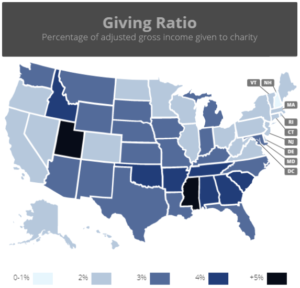This week’s guest post from Kelly Lemmer includes a helpful interactive infographic of giving in the U.S.
 The United States of America is the most charitable country in the world according to a study done by the Charities Aid Foundation. It found that on average, Americans donated 1.44 percent of GDP (gross domestic product). However, in this respect, not every state is created equal.
The United States of America is the most charitable country in the world according to a study done by the Charities Aid Foundation. It found that on average, Americans donated 1.44 percent of GDP (gross domestic product). However, in this respect, not every state is created equal.
We dove in deeper trying to understand how each state donated individually and created a helpful, interactive infographic that really shows how charitable giving differs from state to state. The data gives some intriguing insight into not only who donates, but also why.
Here are some observations we took from it.
Key Findings
-
- Two states had a higher than five percent giving ratio (percentage of adjusted gross income given to charity): Utah – 6.61 percent and Mississippi – 5.04%. With seven other states coming in at over four percent.
-
- The South showed its hospitality performing very well in the study with Mississippi, Tennessee, Georgia, Oklahoma, Alabama, North Carolina, Arkansas, South Carolina, and Texas all finishing inside the top 15.
- New England performed poorly. Specifically, New Hampshire, which only donates 1.85 percent, coming out to just under $1,500 per household annually – the lowest in the entire country.

Click the map above to see the interactive version.
-
- The West Coast also under performed with the exception of Washington. With both California and Oregon both coming in at under three percent.
-
- Idaho, a strongly Republican state, came in at 4.2 percent which isn’t too surprising considering its demographic. But what is impressive about their level of giving is the fact that Idaho doesn’t have a single charity listed inside the top 400 largest in the nation. This means they give more than the majority of American states, without having a major charity readily available.
-
- There doesn’t seem to be a direct correlation between money and time volunteered. Utah leads in both amount of money given and volunteering time, but Mississippi who comes in second in percentage of money, ranks 47th in time volunteered.
-
- States that ranked higher in per-capita church attendance consistently ranked higher in amount of money donated. This was true on the opposite side of the spectrum as well with New Hampshire having a low percentage of church-goers per-capita to go along with its last place rank for money donated.
- Families with incomes of $50,000 to $100,000 a year donated roughly 40% more than those with larger incomes.
Obviously, the map and its data aren’t foolproof, as there are some nuances that you must take into account when you analyze this type of data. First off, these statistics only take into account legally claimed contributions, and over two-thirds of Americans never itemize their donations making it impossible to consider them.
Want to find out where you state stacks up comparatively with your surrounding neighbors or across the country? Go to the graphic here to understand where and from whom the $373 billion dollars that was donated in 2016 came from.
 About Kelly Lemmer: Kelly is a strategist at Rawhide Boys Ranch a nonprofit organization that offers residential care and outpatient mental health services dedicated to helping at-risk youth and their families lead healthy, responsible lives.
About Kelly Lemmer: Kelly is a strategist at Rawhide Boys Ranch a nonprofit organization that offers residential care and outpatient mental health services dedicated to helping at-risk youth and their families lead healthy, responsible lives.
Want to learn more about how to engage YOUR donor community to give more this year? View this free web class replay to learn how!







Were political donations included in this study? I would imagine that a large percentage of “charitable” giving in New Hampshire is to candidates.
Good to hear from you, Katie! While I’m not certain, my assumption is that political fundraising was not included as it is not part of what we usually refer to as “charitable” giving. What was being tracked was nonprofit contributions of money and time to nonprofits. Thanks for reading. I hope you are well!